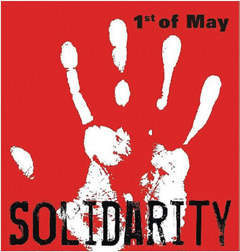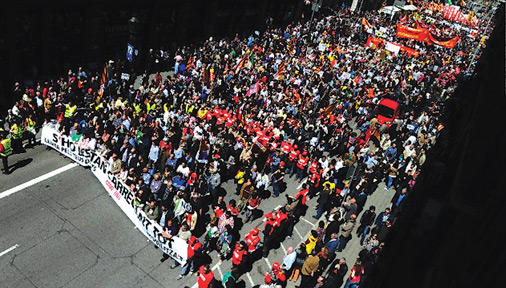Let's remember those who fought for our rights
By Husna Inayathullah
 May 1 is a Government and public holiday in Sri Lanka. May Day
celebrations are held on a large scale in major towns and cities the
world over. Political party leaders greeting the crowds during the
celebrations is a common sight on this day. Workers usually carry
banners with political slogans and many parties decorate their vehicles. May 1 is a Government and public holiday in Sri Lanka. May Day
celebrations are held on a large scale in major towns and cities the
world over. Political party leaders greeting the crowds during the
celebrations is a common sight on this day. Workers usually carry
banners with political slogans and many parties decorate their vehicles.
May Day originated in America and stemmed from the pre-Christian
holiday of Beltane, a celebration of rebirth and fertility. In the late
19th Century, the working class was in a frequent struggle to gain the
eight hour work day as the working conditions were severe and the
ordinary masses had to work 10 to 16 hours a day in unsafe conditions.
In 1860s the working class agitated to shorten the work day without a
cut in pay but it was in 1880s that the organised labourers were able to
gain strength to declare that eight hour work day.
Socialism was a new and attractive idea to working people at this
time, many of whom were drawn to its ideology of working class control
over the production and distribution of all goods and services. Workers
had seen first-hand that Capitalism benefited only their bosses, trading
workers’ lives for profit.
Thousands of men, women and children were dying needlessly every year
in the workplace, with life expectancy as low as early twenties in some
industries, and little hope but death of rising out of their
destitution. Socialism offered another option.
Socialist organisations
Many socialist organisations rose up throughout the later half of the
19th century, from political parties to choir groups. In fact, many
socialists were elected into governmental office by their constituency.
But again, many of these socialists were unsuccessful by the
political process which was so evidently controlled by big business and
the bi-partisan political machine.
Tens of thousands of socialists broke ranks from their parties which
was seen as nothing more than protection for the wealthy, and created
anarchist groups throughout the country.
Literally thousands of working people embraced the ideals of
anarchism, which sought to put an end to all hierarchical structures.
Emphasised worker controlled industry, and valued direct action over the
bureaucratic political process. Anarchists and socialist made up the
labour unions.At its national convention in Chicago, held in 1884, the
Federation of Organised Trades and Labour Unions (which later became the
American Federation of Labour), proclaimed that “eight hours shall
constitute a legal day's labour from and after May 1, 1886.” The
following year, the FOTLU, backed by many Knights of Labour locals,
reiterated their proclamation stating that it would be supported by
strikes and demonstrations.
Misgivings
At first, most radicals and anarchists regarded this demand as too
reformist.Despite the misgivings of many of the anarchists, an estimated
quarter million workers in the Chicago area became directly involved in
the crusade to implement the eight hour work day, including the Trades
and Labour Assembly, the Socialistic Labour Party and local Knights of
Labour. As more and more of the workforce mobilised against the
employers, these radicals conceded to fight for the 8-hour day.
With the involvement of the anarchists, there seemed to be an
infusion of greater issues than the 8-hour day. There grew a sense of a
greater social revolution beyond the more immediate gains of shortened
hours.
On May 1, 1886, more than 300,000 workers in 13,000 businesses across
the United States walked off their jobs in the first May Day celebration
in history. In Chicago, the epicentre for the 8-hour day agitators,
40,000 went out on strike with the anarchists in the forefront of the
public's eye. With their fiery speeches and revolutionary ideology of
direct action, anarchists and anarchism became respected and embraced by
the working people and despised by the capitalists.
|

A May Day rally in Cuba |
Albert Parsons, Johann Most, August Spies and Louis Lingg became
household words in Chicago and throughout the country. Parades, bands
and tens of thousands of demonstrators in the streets exemplified the
workers’ strength and unity, yet didn't become violent as the newspapers
and authorities predicted.
Peace
Many workers continued to walk off their jobs until the numbers
swelled to nearly 100,000, yet peace prevailed. It was not until two
days later, May 3, 1886, that violence broke out at the McCormick Reaper
Works between police and strikers.
For six months, armed Pinkerton agents and the police harassed and
beat locked-out steelworkers as they picketed. Most of these workers
belonged to the “anarchist-dominated” Metal Workers’ Union.
During a speech near the McCormick plant, some two hundred
demonstrators joined the steelworkers on the picket line.
Beatings with police clubs escalated into rock throwing by the
strikers which the police responded to with gunfire.
At least two strikers were killed and an unknown number were wounded.
Full of rage, a public meeting was called by some of the anarchists
for the following day in Haymarket Square to discuss the police
brutality. Due to bad weather and short notice, only about 3,000 of the
tens of thousands of people showed up from the day before. This affair
included families with children and the mayor of Chicago himself.
Speculation
As the speech wound down, two detectives rushed to the main body of
police, reporting that a speaker was using inflammatory language,
inciting the police to march on the speakers’ wagon. As the police began
to disperse the already thinning crowd, a bomb was thrown into the
police ranks. No one knows who threw the bomb, but speculations varied
from blaming any one of the anarchists, to an agent provocateur working
for the police.
Enraged, the police fired into the crowd. The exact number of
civilians killed or wounded was never determined, but an estimated seven
or eight civilians died, and up to forty were wounded. One officer died
immediately and another seven died in the following weeks.
Later evidence indicated that only one of the police deaths could be
attributed to the bomb and that all the other police fatalities had or
could have had been due to their own indiscriminate gun fire.
Aside from the bomb thrower, who was never identified, it was the
police, not the anarchists, who perpetrated the violence.
Eight anarchists namely Albert Parsons, August Spies, Samuel Fielden,
Oscar Neebe, Michael Schwab, George Engel, Adolph Fischer and Louis
Lingg were arrested and convicted of murder, though only three were even
present at Haymarket and those three were in full view of all when the
bombing occurred.
The jury in their trial comprised business leaders in a gross mockery
of justice similar to the Sacco-Vanzetti case thirty years later, or the
trials of AIM and Black Panther members in the seventies.
The entire world watched as these eight organisers were convicted,
not for their actions, of which all of were innocent, but for their
political and social beliefs. On November 11, 1887, after many failed
appeals, Parsons, Spies, Engel and Fisher were hung to death. Louis
Lingg, in his final protest of the state's claim of authority and
punishment, took his own life the night before with an explosive device
in his mouth.
Travesty of justice
The remaining organisers, Fielden, Neebe and Schwab, were pardoned
six years later by Governor Altgeld, who publicly lambasted the judge on
a travesty of justice.
Today we see tens of thousands of activists embracing the ideals of
the Haymarket Martyrs and those who established May Day as an
International Workers’ Day. Ironically, May Day is an official holiday
in 66 countries and unofficially celebrated in many more, but rarely is
it recognised in America where it began.
History has a lot to teach us about the roots of our radicalism. When
we remember that people were shot so we could have the 8-hour day; if we
acknowledge that homes with families in them were burned to the ground
so we could have Saturday as part of the weekend; when we recall 8-year
old victims of industrial accidents who marched in the streets
protesting working conditions and child labour only to be beat down by
the police and company thugs, we understand that our current condition
cannot be taken for granted - people fought for the rights and dignities
we enjoy today, and there is still a lot more to fight for.
The sacrifices of so many people cannot be forgotten or we'll end up
fighting for those same gains all over again. This is why we celebrate
May Day.
|

